How to create an environment that motivates your people
– The Enneagram & Susan Fowler’s model of motivation
One of the first things people ask us when we do leadership trainings for LeadershipSculptor is “How do I motivate my people”. And our response is always “You don’t – you can’t – but you can create a framework so that your people FEEL motivated”. And since this is often one of the last modules we teach, we have these wonderful participants hanging in suspense for three days until we go through a motivation model.
So, knowing how to motivate your people – with the less hidden purpose of having them produce more – is usually top-of-mind for a leader. And various models exist for this. In this article I’m going to try and combine TWO of the models. Why? Because from my perspective it makes sense. One model is the Enneagram and the other is Susan Fowler’s model of motivation which I’ll explain briefly below.
Why the combination?
The combination of the two makes it easier for the individual leader who knows his/her own E-type and those of his team to create a work environment so that the individual feels motivated. Please note: The leader doesn’t motivate but helps create an environment that boosts the individual’s own feeling of motivation.
How can the two models help the leader?
The thing is the Enneagram is a personality typology tool based on motivation and Susan Fowler’s model defines three domains in which we motivate ourselves. Both models are based on deep-seated emotional urges and from that perspective can – perhaps – complement each other quite well.
Susan Fowler has determined three domains that are important for us to feel motivated. These are not new as such and you can draw a line to for instance Herzberg’s Motivation Theory. What I do like about SF’s model is that it’s fairly simple and easy to work with – for instance at the annual appraisal conversation – or just more regular check-ins.
The three domains in Susan Fowler’s model are Autonomy, Relatedness and Competence:
• Autonomy: The emotional need to feel that we have choices, that what we do we do out of our volition and that we’re in the driving seat. We need clear goals and time frames as a means of SUCCESS not of follow-up. Competitions do not motivate us because they’re not based on anything emotional. When we perform it’s driving on a deep-seated need to excel.
• Relatedness: The emotional need to care for and be cared for by others – to feel connected with no ulterior motives, and to feel that we’re contributing to something higher than ourselves. As a leader let it be known that emotoins are fine and ask people how they feel. Do not focus on behaviour. Develop personal values and have them relate to the goals. Connect the work with a higher purpose.
• Competence: The emotional need to feel effective and able to manage the daily challenges and to feel that we’re getting better all the time. As a leader you want to make it possible for the individual to LEARN every day. Set up learning targets – not performance targets. Ask at the end of the day: What did you learn today? What did you learn that will help yourself and others tomorrow?
These are of course short summations and it’s expanded a bit in the article mentioned in the footnote
The Enneagram as a model is based on the motivations of the nine different types or nine different strategies. And in the following I’m going to try and apply Susan Fowler’s theory on top of the Enneagram. I may be wrong (quite likely) and there may be better way of using both models. Probably. But I’d like to invite you to try and consider the result for a bit. If you have a different view, please feel free to comment or e-mail me.
In the following I’m building on the reader having a basic knowledge of the Enneagram so I won’t be explaining the different types.
If you want to know more, there are plenty of sources available and in the footnotes I have a link to my own website where I briefly explain the types.
How are SF’s motivational factors distributed for the different Enneagram types: (the image is better here: https://www.linkedin.com/pulse/how-create-environment-motivates-your-people-mette-hvied-lauesen/?published=t)

I welcome any feedback from the types themselves, from the Enneagram teachers, from motivational experts etc. This is a thought experiment – and it may only work in my thoughts. Let’s find out!
Thank you for reading this and please please do comment and share your experience or feedback.






